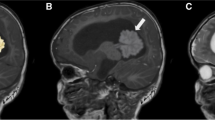Abstract
The management of spinal cord ependymomas in Neurofibromatosis Type 2 (NF2) has traditionally been conservative, in contrast to the management of sporadic cases; the assumption being that, in the context of NF2, they did not cause morbidity. With modern management and improved outcome of other NF2 tumours, this assumption, and therefore the lack of role for surgery, has been questioned. To compare the outcome of conservative treatment of spinal ependymomas in NF2 with surgical intervention in selected patients. Retrospective review at two NF2 centers, Manchester, UK and Paris/Lille, France. In Manchester patients were managed conservatively. In France surgery was a treatment option. Inclusion in the study was based on tumor length of greater than 1.5 cm. The primary parameter assessed was acquired neurological deficit measured by the Modified McCormick Outcome Score. 24 patients from Manchester and 46 patients from France were analyzed. From Manchester, 27% of these patients deteriorated during the course of follow-up. This effectively represents the natural history of ependymomas in NF2. Of the surgical cases, 23% deteriorated postoperatively, but only 2/18 (11%) of those operated on in the NF2 specialist centers. Comparison of the two specialist centers Manchester/France showed a significantly improved outcome (P = 0.012, χ2 test) in the actively surgical center. Spinal ependymomas produce morbidity. Surgery can prevent or improve this in selected cases but can itself can produce morbidity. Surgery should be considered in growing/symptomatic ependymomas, particularly in the absence of overwhelming tumor load where bevacizumab is the preferred option.
Similar content being viewed by others
References
Evans DG, Huson SM, Donnai D, Neary W, Blair V, Newton V, Strachan T, Harris R (1992) A genetic study of type 2 neurofibromatosis in the United Kingdom. II. Guidelines for genetic counselling. J Med Genet 29:847–852
Mautner VF, Tatagiba M, Lindenau M, Fünsterer C, Pulst SM, Baser ME, Kluwe L, Zanella FE (1995) Spinal tumors in patients with neurofibromatosis type 2: MR imaging study of frequency, multiplicity, and variety. AJR Am J Roentgenol 165:951–955. https://doi.org/10.2214/ajr.165.4.7676998
Plotkin SR, O’Donnell CC, Curry WT, Bove CM, MacCollin M, Nunes FP (2011) Spinal ependymomas in neurofibromatosis Type 2: a retrospective analysis of 55 patients. J Neurosurg Spine 14:543–547. https://doi.org/10.3171/2010.11.SPINE10350
Dow G, Biggs N, Evans G, Gillespie J, Ramsden R, King A (2005) Spinal tumors in neurofibromatosis type 2. Is emerging knowledge of genotype predictive of natural history? J Neurosurg Spine 2:574–579. https://doi.org/10.3171/spi.2005.2.5.0574
Lawson McLean AC, Rosahl SK (2016) Growth dynamics of intramedullary spinal tumors in patients with neurofibromatosis type 2. Clin Neurol Neurosurg 146:130–137. https://doi.org/10.1016/j.clineuro.2016.05.006
Plotkin SR, Stemmer-Rachamimov AO, Barker FG, Halpin C, Padera TP, Tyrrell A, Sorensen AG, Jain RK, di Tomaso E (2009) Hearing improvement after bevacizumab in patients with neurofibromatosis type 2. N Engl J Med 361:358–367. https://doi.org/10.1056/NEJMoa0902579
Ferner RE, Shaw A, Evans DG, McAleer D, Halliday D, Parry A, Raymond FL, Durie-Gair J, Hanemann CO, Hornigold R, Axon P, Golding JF (2014) Longitudinal evaluation of quality of life in 288 patients with neurofibromatosis 2. J Neurol 261:963–969. https://doi.org/10.1007/s00415-014-7303-1
Hexter A, Jones A, Joe H, Heap L, Smith MJ, Wallace AJ, Halliday D, Parry A, Taylor A, Raymond L, Shaw A, Afridi S, Obholzer R, Axon P, King AT, Friedman JM, Evans DG, Group ESNR. (2015) Clinical and molecular predictors of mortality in neurofibromatosis 2: a UK national analysis of 1192 patients. J Med Genet 52:699–705. https://doi.org/10.1136/jmedgenet-2015-103290
McCormick PC, Torres R, Post KD, Stein BM (1990) Intramedullary ependymoma of the spinal cord. J Neurosurg 72:523–532. https://doi.org/10.3171/jns.1990.72.4.0523
Constantini S, Miller DC, Allen JC, Rorke LB, Freed D, Epstein FJ (2000) Radical excision of intramedullary spinal cord tumors: surgical morbidity and long-term follow-up evaluation in 164 children and young adults. J Neurosurg 93:183–193
Hagel C, Stemmer-Rachamimov AO, Bornemann A, Schuhmann M, Nagel C, Huson S, Evans DG, Plotkin S, Matthies C, Kluwe L, Mautner VF (2012) Clinical presentation, immunohistochemistry and electron microscopy indicate neurofibromatosis type 2-associated gliomas to be spinal ependymomas. Neuropathology 32:611–616. https://doi.org/10.1111/j.1440-1789.2012.01306.x
Essayed WI, Bernard A, Kalamarides M (2015) Clinical response associated with radiographic regression of a cervicomedullary ependymoma in a NF2 patient treated by bevacizumab. J Neurooncol 125:445–446. https://doi.org/10.1007/s11060-015-1925-8
Farschtschi S, Merker VL, Wolf D, Schuhmann M, Blakeley J, Plotkin SR, Hagel C, Mautner VF (2016) Bevacizumab treatment for symptomatic spinal ependymomas in neurofibromatosis type 2. Acta Neurol Scand 133:475–480. https://doi.org/10.1111/ane.12490
Morris KA, Afridi SK, Evans DG, Hensiek AE, McCabe MG, Kellett M, Halliday D, Pretorius PM, Parry A (2017) The response of spinal cord ependymomas to bevacizumab in patients with neurofibromatosis type 2. J Neurosurg Spine 26:474–482. https://doi.org/10.3171/2016.8
Author information
Authors and Affiliations
Corresponding author
Ethics declarations
Conflict of interest
The authors declare that they have no personal conflicts of interest and no institutional financial interest in any drugs, materials, or devices described in this manuscript.
Rights and permissions
About this article
Cite this article
Kalamarides, M., Essayed, W., Lejeune, J.P. et al. Spinal ependymomas in NF2: a surgical disease?. J Neurooncol 136, 605–611 (2018). https://doi.org/10.1007/s11060-017-2690-7
Received:
Accepted:
Published:
Issue Date:
DOI: https://doi.org/10.1007/s11060-017-2690-7




